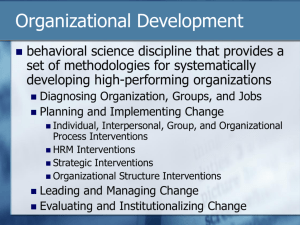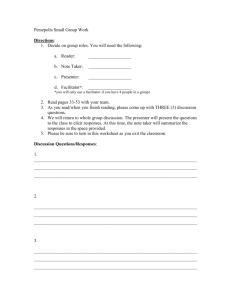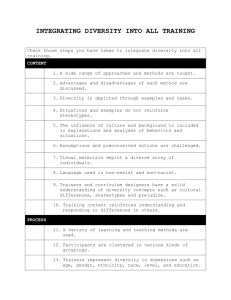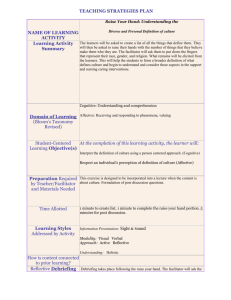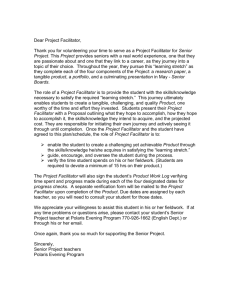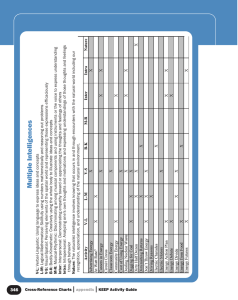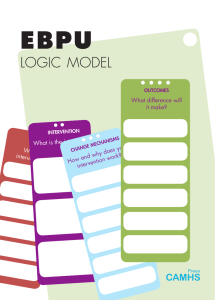The Middle Stage - Foundation Methods
advertisement
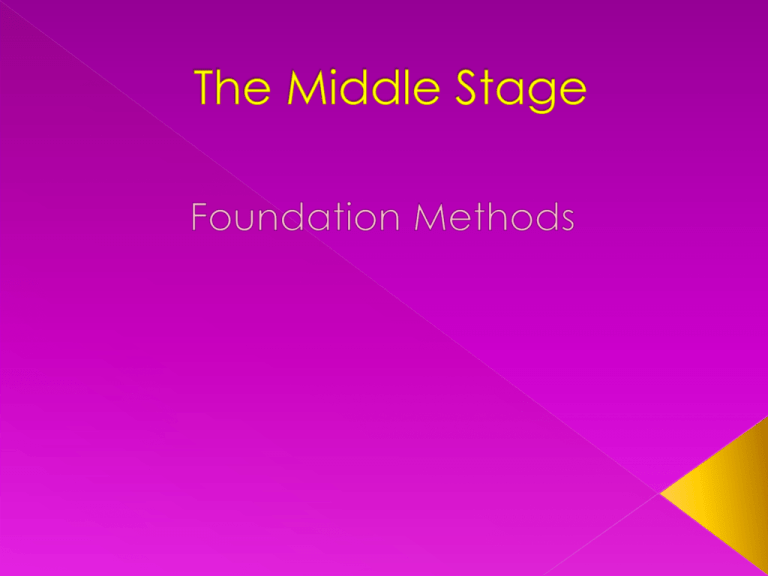
**The primary task of the facilitator during the middle stage is to help members accomplish the goals they have contracted to achieve. After an initial period of testing, conflict, and adjustment by members, the main focus of the middle stage turns to goal achievement. During the middle stage groups are focused on accomplishing goals, objectives and tasks developed earlier in the group. During this stage, the facilitator regularly assesses goal attainment work and helps members make changes based on assessment of: › The group’s development (DYNAMICS) › The changing needs of members (INTRA, INTER, ENVIRONMENT) › The changing demands of the SOCIAL ENVIRONMENT in which the group functions The Middle Stage is a continual cycle of: ASSESSMENT MODIFICATION REASSESSMENT Preparing for group meetings Structuring the group’s work Involving and empowering members Helping members to achieve goals Working with reluctant and resistant members Monitoring and evaluating the group’s progress Prepare an agenda Program materials – activities, games, and exercises designed for fun/interest and goal attainment (also provides medium for assessment) see fig. 9.1 Review recordings of previous meetings and data from other sources Visualizing how meeting should be conducted Structure is the use of planned, systemic, time-limited interventions and program activities. The degree of structure in a group can be variable. › Pro: Structure is an efficient means to learn new skills and helps provide consistency, safety, etc. › Con: Less structure allows more group interaction and ownership During the middle stage, a facilitator can perform a variety of activities to structure a group’s work: Inform members about beginning and ending group on time (manage “doorknob” communications) Give attention apportioning time for ending meetings and providing summary of session Set verbal or written agendas – allow member input when preparing and presenting Establish and maintain orderly communication and interaction patterns Help members progress towards their goal – determine how much time should be spent on each member’s goal Attend to smooth transitions between group activities Focus on multi-level interventions: Individual (INTER, INTRA, ENVIRONMENT) Group-as-a-whole (GROUP DYNAMICS) External environment **The ultimate goal of system interventions is to empower members so that they can take charge of their own lives both within the intervention process (in this case, the group) and outside of it. Show belief in members’ strengths Acknowledge difficulties and obstacles Let members know they have a stake in the content and direction of the group Praise members for reaching out to one another Encourage members to try out new behaviors and actions within and outside of the group Program activities A portion of a treatment group’s work should always be devoted to maintaining a group’s optimal functioning – attending to the group’s DYNAMICS (Cohesion, Culture, Social Control Mechanisms, & Communication and Interaction Patterns) – but MOST of an effective group’s time during the middle stage should be focused on HELPING MEMBERS ACHIEVE THEIR GOALS. Contracting for treatment goals is an evolving process: › Tentative agreement/contract during planning stage › Contract reaffirmed and made more concrete during the beginning stage › Focus of middle stage is on carrying out developed goals and contracts – secondary contracts may be developed HELP MEMBERS MAINTAIN THEIR AWARENESS OF THE GOALS THEY IDENTIFIED AND AGREED TO WORK ON IN THE BEGINNING STAGE › Facilitators should never assume that members remain aware of their goals as the group progresses › Develop a process for reviewing treatment goals and contracts: It is a good practice to go round the group at the beginning of each session to review these and identify accomplishments and/or obstacles DEVELOPING TREATMENT PLANS (a continuation of goal-setting) › For the group-as-a-whole › For the individual Enlist support of all group members - “helpertherapy” principle Guided group discussion on specifics Exploration of alternatives Assess for additional information Creation of tasks to accomplish goals – between and in meetings OVERCOMING OBSTACLES TO MEMBERS’ WORK › “Demand for work” › Careful analysis of goal/contract › Increasing member motivation › Use of “how” or “what” questions (avoid “why”) › Help members decide which action to take Use of five intervention roles” (pg. 272) › Enabler › Broker › Mediator › Advocate › Educator Point out consequences of refusal Clarify non-negotiable aspects of participation Develop non-judgmental, accepting, and safe group environment Assess members’ motivation for being there Adopt a position that maximizes members’ sense of control and expertise Acknowledge members’ feelings and reactions to being in the group Reframe resistance- acknowledge anger Assess source of resistance (Worker, Client, Environment) Avoid moralizing or blaming Use “I” statements Use constructive confrontations Allow member to member confrontation (but don’t expect too early in the group and be prepared to intervene if it is not done constructively) Monitoring and evaluating progress provides feed-back for workers and members, which is useful in developing, modifying, and changing treatment plans. It is also helpful for maintaining the functioning of the group-as-a-whole. Information should be systematically solicited, collected, and acted on. Evaluation forms are one of the most commonly used methods of obtaining feedback and can be used to assess: › Facilitator › Individual › Group-as-a-whole
